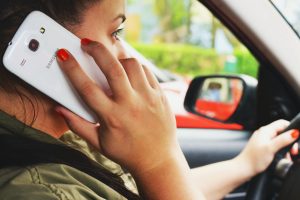A shocking 57 percent of all motorists were using their cell phones within one minute of crashing this year, according to a recent study by transportation analytics firm Zendrive. Nearly 17 percent of motorists in crashes had been using their phones in the five-second window just before. 
Study authors culled data from more than 86,000 crashes that took place in the U.S. throughout this year. What they found was that not only were there record-setting crash rates – even amid pleas to stay home and social distance – but that these very often included some form of distracted driving. Even more troubling, distraction appeared to grow worse as the year wore on.
Of course, distracted driving is a problem that existed long before 2020. Unfortunately, it seems likely to continue being a scourge for years to come. The upheaval in travel patterns of late serves only to highlight this longstanding issue.
Sending a single text message can tear a driver’s eyes away for nearly 5 seconds. If you’re traveling 70 mph (the maximum speed on most Florida highways), that’s like traveling 1.5 football fields completely blind. While a blood-alcohol level of 0.08 percent is associated with a 12.5 percent reduction in reaction times, sending a text message or engaging on a social media site is associated with a 38 percent reduction in reaction time.
As we prioritize the health and safety of our community in many other ways in the coming year, our South Florida injury lawyers urge everyone to do so on the road as well.
Liability for Distracted Driving Crashes in Florida
Texting while driving is illegal in Florida. F.S. 316.305, passed in 2019, made the action a primary offense, meaning law enforcement can initiate a stop and issue a citation solely on this basis.
As our West Palm Beach car accident attorneys can explain, a driver who is distracted behind the wheel is not using reasonable care – a legal duty they owe to other road users. If that driver causes a crash, they can be held legally responsible to pay the resulting damages (medical bills, lost wages, pain and suffering, etc.).
Establishing liability on the basis of distraction, however, can be a bit tricky. It’s not like drunk driving, which has a clear biological test. Still, some avenues to explore when building a case include:
- Evidence gleaned at the scene by witness statements/accident reports. This would include any testimony or photographic evidence that the driver had the phone in their hand. It might also include any admission of guilt or apology by the driver or other spontaneous utterance anyone made about the driver being distracted.
- Cell phone records. If the individual was sending text messages or talking on the phone or taking pictures or recording video at the time of the crash, cell phone records may show this. They will likely have to be subpoenaed.
- Social media activity. We can follow an electronic trail that may tell us what the person was doing on their phone – and when. Encrypted data from certain apps, social media platforms, email carriers, web browsing providers can provide evidence that may point to driver distraction. Certain activity may be time-stamped.
- Vehicle data. Many newer model vehicles are equipped with special monitors that can tell us more about the driver’s behavior behind the wheel. We may be able to learn how fast they went, whether the car radio or other electronic controls were being tampered with and even whether someone made any attempt to engage their brakes before the crash. (A rear-end collision wherein the rear driver made no attempt to yield or stop is increasingly a top indicator that the rear driver was distracted.)
- Accident reconstruction experts. Debris, tire patterns and other forensic evidence – when pieced together – may indicate driver distraction.
- Surveillance footage/traffic camera recordings. Video surveillance footage is everywhere these days, including in larger metropolitan areas like West Palm Beach, Miami and Fort Lauderdale. Distracted drivers are increasingly ending up “caught on camera.”
These pieces of evidence may help strengthen your leverage in negotiation with insurers or help you win the case at trial. If you have been injured in a distracted driving accident in South Florida, our dedicated civil trial lawyers will work to help you recover your fair share of compensation.
Contact the South Florida personal injury attorneys at Halberg & Fogg PLLC by calling toll-free at 1-877-425-2374. Serving West Palm Beach, Miami, Tampa, Orlando and Fort Myers/ Naples. There is no fee unless you win.
Additional Resources:
Zendrive Collision Report, 2020
More Blog Entries:
Florida Dangerous Instrumentality Doctrine in Car Accident Cases, Nov. 5, 2020, West Palm Beach Car Accident Lawyer Blog
 South Florida Injury Lawyer Blog
South Florida Injury Lawyer Blog

